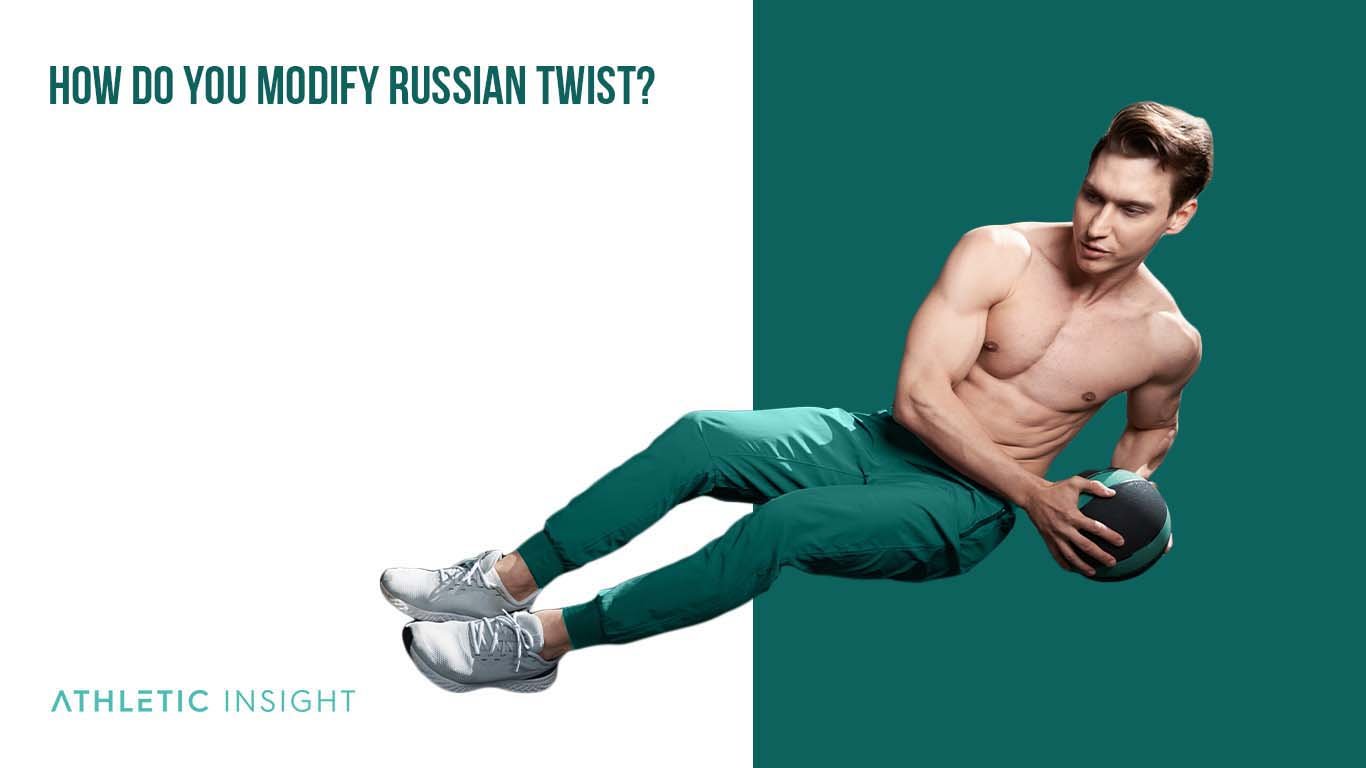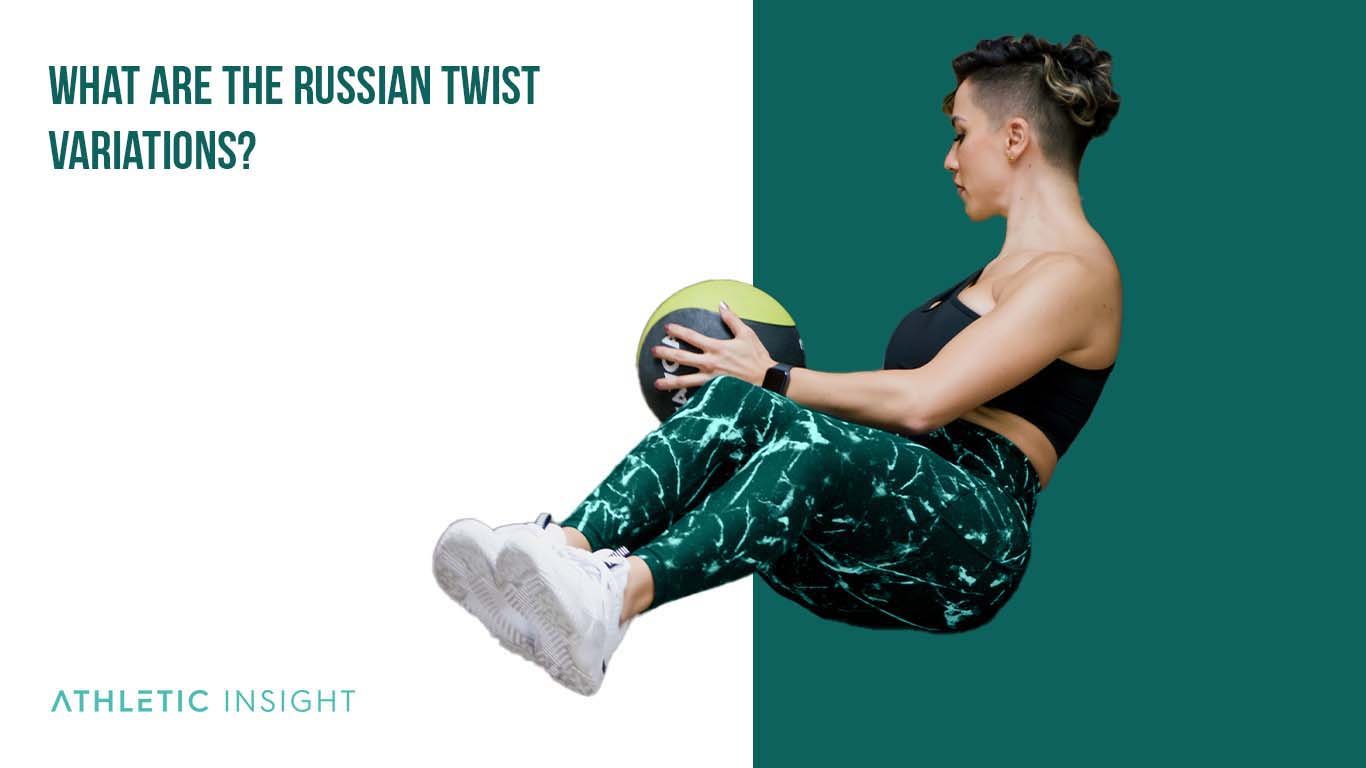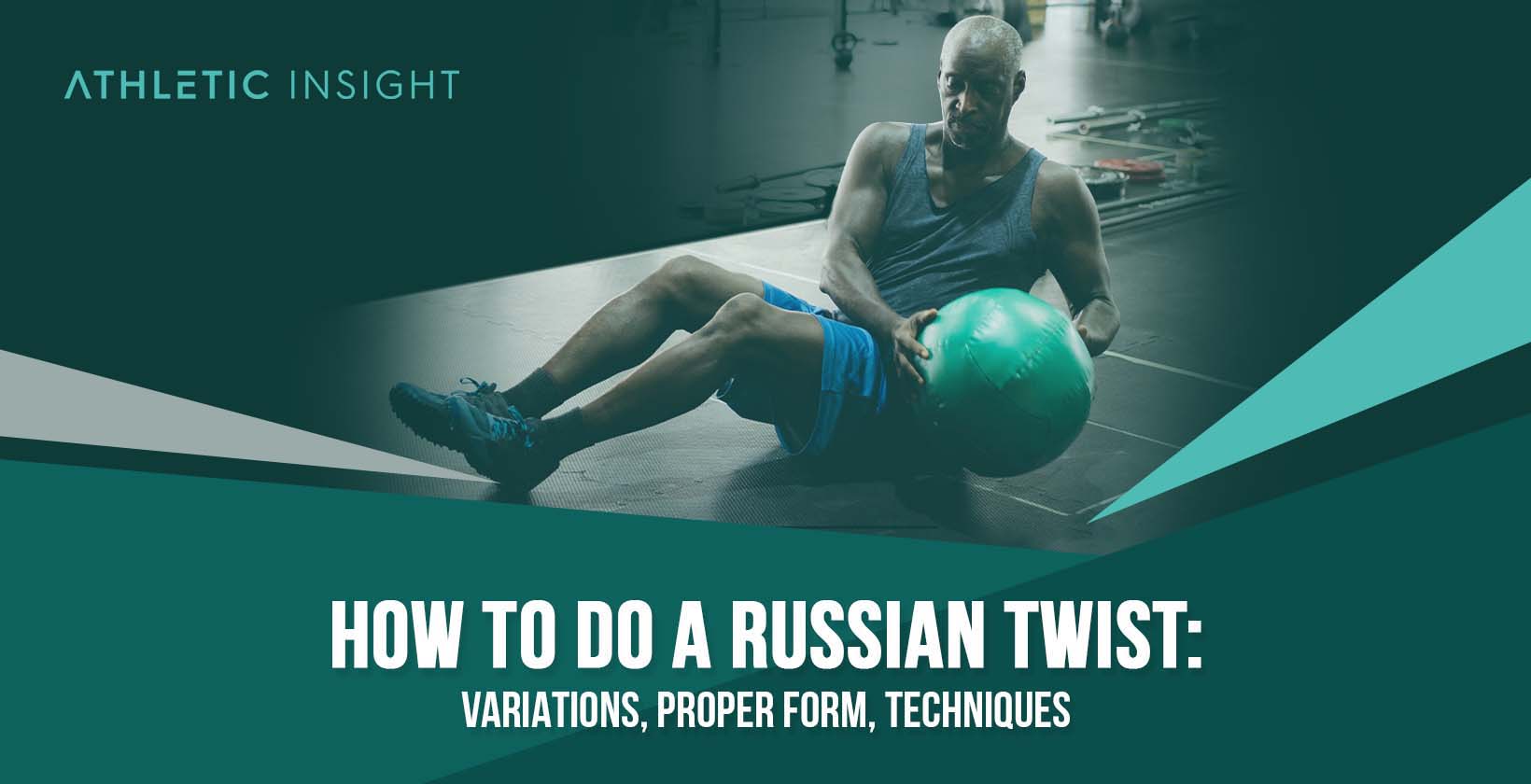A Russian twist (also known as a Romanian twist) is a core workout that targets the abdominal muscles. The Russian twist is performed by sitting down with your knees bent at a 90-degree angle, and your lower back at a 45-degree angle off of the ground, while engaging your abdominal muscles as you twist your upper body from side to side. It is easy to learn and perform, and it is one of the best moves to strengthen your core.
The Russian twist exercise has many benefits. It improves your isometric core strength, serves as anti-rotational training, helps you manage your weight, and targets many muscles.
Whether you do your Russian twist techniques with weights or not, this move targets your obliques, transverse abdominis, erector spinae, latissimus dorsi, rectus abdominis, hip flexors, and scapular muscles. If you want defined abs, improved posture, and a strong back, you should try out these twists.
Engaging in proper Russian twist form will minimize your risk of injury and maximize your muscle growth. To exercise with the correct form, you need to do the following.
- Sit on the floor
- Lean backward until your core is engaged
- Tuck in your chin
- Keep your arms in front of your chest
- Rotate your body left and right in a slow, controlled manner
In the twist guide that follows, we will cover four Russian twist variations. These include weighted, cross-legged, punch, and decline twists.
When performing a body twist, some common mistakes could lead to injury. For instance, you could lean back too far, curve your spine, lift your legs too high, or use a too-heavy weight. These mistakes could damage your back and cause you to pull a muscle.
By engaging in the correct Russian twist techniques, you can avoid these errors and keep yourself safe. Keep reading to learn more about Russian twists.
How to Perform Russian Twist With Proper Form
Proper form is an essential part of resistance training. It primarily concerns the quality of your movement. You can exercise with proper form by using the correct spinal alignment, tension, range of motion, and joint positioning.
Focusing on these factors will improve your strength in fewer Russian twist reps. To dominate the Russian twist, follow these steps.
- Sit on your rear end with your knees bent and sit bones rooted. You can elevate your feet slightly to increase the intensity of the side twist.
- Lean back until you reach a 45-degree angle with the floor. You will need to engage your abs to stay in this position. Ensure you keep your spinal column aligned by elongating and straightening your back.
- Check that your body is in a V-shape. Try to keep your knees bent at a 90-degree angle in parallel with the floor.
- Clasp your hands and extend your arms straight in front of you. Lengthening your arms increases the resistance involved in the exercise.
- Now that you are in the proper starting position brace your core and twist to the right in a slow, controlled manner. Turn back to the center before twisting to the left. Make sure to use your abdominals to reduce the strain on your back and target the correct muscles.
- Repeat the seated Russian twist for 2-3 sets of 8-16 reps.
By learning how to do a Russian twist properly, you can receive all of the benefits of a Russian twist without injuring yourself.
What Are the Benefits of Russian Twist?
Ab twist exercises have many benefits, especially the Russian Twist. By understanding these advantages, you can better understand the importance of form and feel more motivated to implement twisting exercises in your exercise routine.
Some of the benefits of Russian twists include the following.
- Strengthening your core: Russian twists build isometric core strength. The twisting motion involves concentric and eccentric movements. Since you need to keep an isometric contraction in your abdominals, you can develop functional strength as you brace your core while moving. Furthermore, this move targets most of the muscles in your core.
- Strengthening your obliques: Building muscle mass in your obliques through Russian twists can increase your neural awareness, help you engage your core, reduce injury, and increase your strength. Traditional ab exercises like crunches do not target your entire core in the way that Russian twists do. Many skimp on the obliques in particular.
- Strengthening your spine: If you experience back pain, you may need to develop your core strength. Sitting twists will help. This exercise targets muscles throughout your abdomen and back to help you strengthen and stabilize your spine. You can improve your posture and maintain proper spinal alignment throughout the day.
- Working your balance: One benefit of this torso twist exercise is improving balance. You develop core strength during motion, which can help you with motions like walking, running, and standing on one leg.
- Building stability in your spine: Russian twists are a form of anti-rotational training. This movement will help you resist spinal rotation. The spine is susceptible to shear forces from turning that can lead to injury. By performing small twists through this exercise, you can build stability by strengthening your obliques and back.
What Are the Mistakes for Russian Twist Form?
When performed improperly, the Russian twist can lead to injury. The correct technique will put only minimal shear force on your spine, but mistakes in form could injure you from extensive stress on your spine.
By engaging in good Russian twist form, you can reduce the amount of stress you place on your back muscles (latissimus dorsi and erector spinae). Also, engaging your transverse abdominis, obliques, hip flexors, and rectus abdominis can reduce your risk of back injury.
Here are some Russian twist mistakes that you should avoid.
- Arching or rounding your back: Rounding your back can reduce fatigue in the short term, but it makes the exercise less effective as you stop engaging your abdominal muscles. Also, you can increase your risk of muscle strain or back pain.
- Twisting too fast: You can increase time under tension by performing your Russian twist at a slow speed. You can engage your core longer and avoid using momentum. Moving too quickly causes you to rely on momentum, which could cause you to twist too far and injure your back.
- Moving your knees: You will rely on momentum and reduce your torso rotation if you let your knees move during the exercise. This mistake lessens core engagement and makes the workout less effective for developing oblique strength.
- Twisting your lower back: During the Russian twist, you want your back to remain stable. It should not twist along with your abs. Moving your lower back means you are not staying rigid enough in your torso, which can lead to injury from the excessive shear force. Instead, try to twist through the middle of your chest.
- Leaning too far back: You want to keep your spine straight during this exercise, which might not happen when you lean back too much. You are more likely to slouch, which reduces core engagement and may cause lower back pain.
How Do You Modify Russian Twist?
A couple of Russian twist modifications can help you gain the foundational strength to perform the exercise correctly.
The most accessible modification involves keeping your feet on the ground. If you are struggling with maintaining your spinal alignment, this modified Russian twist will help you focus on lengthening your spine and increasing your range of motion. This modification reduces the strain on your hip flexors as well.

You can also perform the Russian twist with bent elbows. Keeping your hands closer to your chest can help you focus on straightening your back and engaging your core. Since your arms are closer to your body, you will reduce some of the resistance in the exercise to make it easier.
Which Muscles Are Involved While Performing Russian Twist?
Russian twists involve most of the muscles in your torso, including the following.
- Obliques: Your obliques are your side muscles. Twisting motions directly contract them, which helps them develop concentric strength.
- Transverse abdominis (TVA): Your TVA is the deepest muscle layer in your abdomen. It is called the corset muscle because it wraps horizontally between your lower ribs and pelvis. Strengthening this muscle can benefit your posture and tighten your waist.
- Erector spinae: The erector spinae muscles run vertically down your spine. By strengthening these muscles, you can improve your posture.
- Latissimus dorsi: Russian twist exercises won’t help you build massive lats, but they can help you engage them more readily during moves like pull-ups and lat pulldowns.
- Rectus abdominis: Strengthening your rectus abdominis will help pull in abdominal muscles and create the classic six-pack look. Also, a strong rectus abdominis will improve your jumping performance.
- Hip flexors: The Russian twist abs workout engages your hip flexors. Strong hip flexors can reduce hip and low back pain while preventing injury from everyday activities like walking, sitting, and dancing.
- Scapular muscles: Twisting motions help you engage your scapular muscles and improve shoulder mobility.
What Are the Russian Twist Variations?
The variations of Russian Twist are alterations to the exercise that increase the intensity. We will cover four popular supine twist variations.
To complete weighted twists, you hold a medicine ball, kettlebell, dumbbell, or weight plate with both of your hands while in the traditional Russian twist form. You can keep your arms extended in front of you or tap the weight on the floor with each twist. This variation works well with the two modifications mentioned above as well.

You cross one calf over the other when completing leg-cross twists. You can do this variation by crossing your right leg over the left while twisting right, undoing the cross in the center, and crossing the left calf over right while twisting left.
Otherwise, you could do a specific number of reps with one leg on top and switch legs for the rest of the repetitions. Your feet need to be elevated with this variation, but you can choose where you position your arms.
For punch twists, you punch the air with your fists as you twist. You keep your arms in at your chest from a neutral Russian twist position. As you twist to the right, punch your left arm to the right side. Switch directions on the opposite side. You can do this with your feet elevated or on the ground.
If you have a decline bench, you can perform decline twists. Sit on the bench, align your spine, and twist side to side. You can achieve this variation weighted or unweighted, and your arms can be any distance from your chest.
What Is the Necessary Equipment for Russian Twist?
Russian twists do not require much equipment. All you need is the following items.
- Fitness mat or cushioned surface
- Weight: kettlebell, dumbbell, medicine ball, weight plate (optional)
- Decline bench (optional)
Best Russian twist barbells can be used while performing this exercise.
What Are the Core Muscle Exercises With Russian Twist?
The Russian twist is one of the best core exercises to target your obliques. By including it with other abdominal exercises, you can develop a balanced core. Here is a sample program using the Russian twist for core strength.
- 3×12 reverse crunches
- 3×12 weighted Russian twists
- 2×8 roll-ups with a dumbbell
- 3×8 weighted dead bugs on each side
- 3x30s plank holds
What Are the Russian Twist Related Facts?
Here are some reasons why the Russian Twist is the best exercise.

- Russian twists are still called Russian twists in Russia.
- Other names for this exercise are Roman twist and Romanian twist.
- Many bodybuilders do not recommend the Russian twist as it can injure your back if performed incorrectly and overdevelop your obliques, which can widen the appearance of your waist.
Does Russian Twist Affect the Hormones?
Low-impact exercises like Russian twists can balance hormones by reducing stress, increasing flexibility, and improving balance. This movement can improve levels of estrogen, testosterone, human growth hormone, cortisol, insulin, norepinephrine, brain-derived neurotrophic factor, and epinephrine.
You can build muscle with Russian twists because they increase human growth hormone and testosterone while managing cortisol levels.
Does Russian Twist Affect the Mood?
Yes, a Russian twist can positively impact your mood. Studies show that increases in physical activity can reduce the chance of becoming depressed by over 26%. Since it manages cortisol levels, the Russian twist can also reduce stress and anxiety.
Is Russian Twist Practiced Within CrossFit?
Yes, the Russian twist is practiced in CrossFit. It strengthens multiple muscles at once, making it a valid exercise for programs in CrossFit definition.
Is Russian Twist a Military Movement?
While no military exercises test uses the Russian twist, they recommend the movement to develop core strength.
Is Russian Twist Dangerous?
Yes, the Russian twist can be dangerous if you round your back, rely on momentum, twist too fast, or use a too-heavy weight. They can apply a shear force to your spine that causes damage in the long run.
Is Russian Twist Essential?
No, the Russian twist is not an essential exercise. You can develop total core strength with exercises like deadlifts, squats, planks, push-ups, knee-to-elbow hangs, and pull-ups. To target your obliques, you can also try medicine ball rotational throws, woodchoppers, and side planks. Russian twist movements look like more fundamental human movements.
What Are Alternative Russian Twist Exercises?
Here are some alternative exercises to the Russian twist.
- Swiss ball side crunch
- Dumbbell side bend
- 45-degree side bend
- Bodyweight side crunch
- Kneeling side plank
- Kneeling pelvic tilt
- Band anti-rotation hold
- Rope horizontal chop
- Rope half-kneeling horizontal chop
- Exercise ball jackknife
- Cable torso rotation



